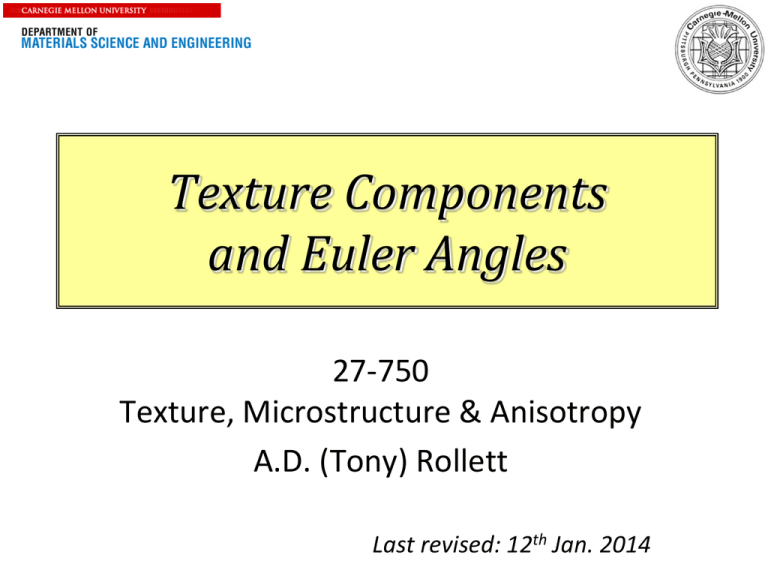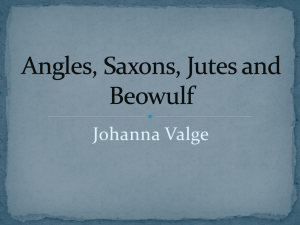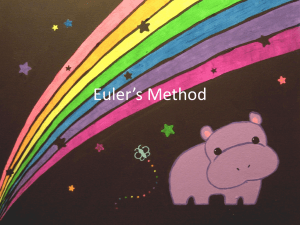Texture Components, Euler angles
advertisement

1
Texture Components
and Euler Angles
27-750
Texture, Microstructure & Anisotropy
A.D. (Tony) Rollett
Last revised: 12th Jan. 2014
2
Lecture Objectives
• Show how to convert from a description of a crystal
orientation based on Miller indices to matrices to Euler
angles.
• Give examples of standard named components and their
associated Euler angles.
• The overall aim is to be able to describe a texture component
by a single point (in orientation space, which is parameterized
with some set of coordinates such as Euler angles) instead of
needing to draw the crystal embedded in a reference frame.
• Homework exercises will be converting Miller indices to Euler
angles.
Obj/notation AxisTransformation Matrix EulerAngles Components
3
(hkl)[uvw], Miller Index Definition
of a Crystal Orientation
•
We use a set of three orthogonal (mutually perpendicular) directions as the reference
frame. Mathematicians set up a basis set of unit vectors called e1 e2 and e3. All directions
can then be described as (linear) combinations of the three basis vectors. See the
Supplemental Slides for explanations of vectors and unit vectors.
•
In many cases we use the metallurgical names Rolling Direction (RD) // e1, Transverse
Direction (TD) // e2, and Normal Direction (ND) // e3.
•
We then identify a crystal (or plane normal) parallel to 3rd axis (ND) and a crystal direction
parallel to the 1st axis (RD), written as (hkl)[uvw]. The second axis is then completely
specified by the other two. This situation is sometimes referred to as “biaxial texture”, to
distinguish it from “uniaxial texture” in which only one crystal axis of each grain is aligned
with the specimen.
•
In thin films, we must still use a reference frame with 3 axes but very often, only the
normal direction (ND) or film-plane-normal matters because only one crystal direction is
aligned with the ND, which is the uniaxial texture referred to above. Be aware, however,
that an epitaxial thin film can be biaxially aligned to the substrate in which case all 3 axes
are relevant. This latter case is important to High Temperature Superconductor
processing, for example.
4
Orientation specification via
(hkl)[uvw]
≡Z≡e3
(hkl) ∕ ∕ Z
≡Y
≡e2
≡X≡e1
[uvw] ∕ ∕ X
Obj/notation AxisTransformation Matrix EulerAngles Components
5
Active versus Passive Rotations
•
•
•
•
Before we discuss the details of how to calculate orientation matrices, it is a good idea
to summarize the difference between “active” and “passive” rotations, as
mathematicians know them.
In materials science, we are mostly concerned with describing anisotropic properties of
crystals and the aggregate anisotropy of polycrystalline materials, for which it is
convenient to use tensors to describe those properties.
For tensor quantities, we commonly need their coefficients in either the sample frame
or the crystal frame. For this we use “transformations of axes”, which are “passive
rotations”, in the sense that the two frames share a common origin and differ by only a
(proper) rotation. The tensor quantities do not rotate in real space, however.
In solid mechanics, however, it is more typical to need to describes the motions of
objects. Certain motions are just rotations and one can think of rotating a vector, for
example, about the origin, in which case one is describing an “active rotation”. Some
object is rotated about the origin and moves through the frame.
• For all work in texture we will consistently use axis transformations,
a.k.a. passive rotations.
6
Rotation of axes in the (2D) plane:
x, y = old axes; x’,y’ = new axes
y º eˆ2
y ¢ º eˆ2¢
v
x ¢ º eˆ1¢
æ cos q sin q ö
÷v
v¢ = ç
è - sin q cos q ø
q
x º eˆ1
N.B. Passive Rotation/ Transformation of Axes
Obj/notation AxisTransformation Matrix EulerAngles Components
7
Definition of an Axis Transformation:
ê = old axes; ê′= new axes
We transform the coefficients of, e.g., a vector, v, from one set of axes to another
From Sample to
Crystal (primed)
aij = eˆi¢ · eˆ j
æ a11 a12
= ç a21 a22
ç
è a31 a32
a13 ö
a23 ÷
÷
a33 ø
ê’3
ê3
v
ê’2
ê2
ê1
ê’1
Obj/notation AxisTransformation Matrix EulerAngles Components
8
Geometry of {hkl}<uvw>
Sample to Crystal (primed)
Miller index
notation of
texture component
specifies direction
cosines of crystal
directions // to
sample axes. Form
the second axis from
the cross-product of
the 3rd and 1st axes.
^
e’3
[001]
^
e3 // (hkl)
[010]
^
e’2
^
e2 // t
^
e1 // [uvw]
t = hkl x uvw
^
^
e’1
[100]
Obj/notation AxisTransformation Matrix EulerAngles Components
9
Form matrix from Miller Indices
Basic idea: we can construct the complete rotation matrix from two
known, easy to determine columns of the matrix. Knowing that we
have columns rather than rows is a consequence of the sense of
rotation, which is equivalent to the direction in which the axis
transformation is carried out.
(h,
k,
l)
nˆ = 2
2
2
h + k +l
ˆ ´ bˆ
n
ˆt =
nˆ ´ bˆ
bˆ =
(u, v, w)
u +v +w
2
2
2
Sample
æ b1 t1
aij = Crystal ç b2
t2
ç
è b3 t3
n1 ö
n2 ÷
÷
n3 ø
Obj/notation AxisTransformation Matrix EulerAngles Components
10
(Bunge) Euler Angle Definition
[Bunge]
•
•
•
•
The three reference axes are
labeled as X, Y & Z; also
commonly known as ND, RD,
and TD.
The three crystal axes are
labeled as X’, Y’ & Z’ ; also
commonly known as [100], [010]
& [001] in cubic crystals.
The reference (sample) frame is
labeled as “KA” in the figure, and
the crystal frame as “KB”.
Each diagram shows successive
rotations, more properly
thought of as transformations of
axes.
Obj/notation AxisTransformation Matrix EulerAngles Components
11
Euler Angles, Animated
e’3= e3=Zsample=ND
[001]
zcrystal=e3’’’
= e”3
f2
Crystal
f1
3rd position (final)
nd position
2
[010]
1st position
ycrystal=e2’’’
e”2
e’2
e2=Ysample=TD
RD
F
TD
Sample Axes
xcrystal=e1’’’ [100]
e’1 =e”1
e1=Xsample=RD
Obj/notation AxisTransformation Matrix EulerAngles Components
12
Cube Texture (001)[100]:
cube-on-face
• Observed in recrystallization of fcc metals
• The three crystal axes, <001>, are parallel to
the three sample axes, i.e. ND, RD, and TD
directions.
[001]
[100]
[0-10]
Obj/notation AxisTransformation Matrix EulerAngles Components
13
Sharp Texture (Recrystallization)
• Figure on the left shows the {001} pole figures (PFs) for this texture
component: maxima correspond to {100} poles in the standard
stereographic projection aligned with the sample axes. Note that this
pole figure could not be measured experimentally unless transmission
and reflection methods were to be combined because the reflections on
the edge of the PF cannot be detected (see lecture on PF measurement).
Obj/notation AxisTransformation Matrix EulerAngles Components
14
Euler angles of Cube component
• The Euler angles for this
component are simple, and yet
not so simple!
• The crystal axes align exactly with
the specimen axes, therefore all
three angles are exactly zero:
(f1, F, f2) = (0°, 0°, 0°).
æ 1 0 0ö
ç
÷
0
1
0
ç
÷
ç
÷
0
0
1
è
ø
• Rodrigues vector: [0,0,0]
• Orientation Matrix:
• As an introduction to the effects
of crystal symmetry: consider
aligning [100]//TD, [010]//-RD,
[001]//ND. This is evidently still
the cube orientation, but the
Euler angles are
(f1,F,f2) = (90°,0°,0°)!
• Unit quaternion: [0,0,0,1]
Obj/notation AxisTransformation Matrix EulerAngles Components
15
{110}<001>: the Goss Component
• This type of texture is known as Goss Texture and
occurs as a Recrystallization texture for FCC materials
such as Brass, …
• In this case the (011) plane is oriented towards the
ND and the [001] inside the (011) plane is along the
ND
RD.
(110)
TD
[001]
[100]
RD
Obj/notation AxisTransformation Matrix EulerAngles Components
16
{110}<001>: cube-on-edge
• In the 011 pole figure, one of the poles is oriented
parallel to the ND (center of the pole figure) but the
other ones will be at 60° or 90° angles but tilted 45°
from the RD! (Homework: draw the (111) pole figure by
hand.)
ND
(110)
[001]
[100]
TD
RD
{110}
17
Euler angles of Goss component
• The Euler angles for this
component are simple, and yet
other variants exist, just as for
the cube component.
• Only one rotation of 45° is
needed to rotate the crystal
from the reference position (i.e.
the cube component) to
(011)[100]; this happens to be
accomplished with the 2nd
Euler angle.
• (f1,F,f2) = (0°,45°,0°).
• Other variants will be shown
when symmetry is discussed.
• Matrix:
æ1
0
0 ö
ç
÷
0
1/
2
1/
2
ç
÷
ç
÷
è0 -1/ 2 1/ 2 ø
• Rodrigues vector:
[ tan(22.5°), 0 , 0 ]
• Unit quaternion:
[ sin(22.5°) , 0, 0, cos(22.5°)]
• Note that, since there is only
one non-zero Euler angle, the
rotation axis is obvious by
inspection, i.e. the x-axis. For
more general cases, the rotation
axis has to be calculated.
Obj/notation AxisTransformation Matrix EulerAngles Components
18
Brass component
• This type of texture is known as Brass Texture
and occurs as a rolling texture component for
materials such as Brass, Silver, and Stainless
steel.
(110)[1 12]
Obj/notation AxisTransformation Matrix EulerAngles Components
19
Brass component, contd.
• The associated (110) pole figure is very similar to the
Goss texture pole figure except that it is rotated
about the ND. In this example, the crystal has been
rotated in only one sense (anticlockwise).
(100)
(111)
(110)
(110)[1 12]
Obj/notation AxisTransformation Matrix EulerAngles Components
20
{110}<112> Brass component
• Think of
rotating the
Goss
component
around the
ND. In this
example, the
xtal has been
rotated in
both senses
(two variants).
Brass
{110}< 112>
(110)
_
(112)
_
(111)
21
Brass component: Euler angles
• The brass component is convenient
because we can think about performing
two successive rotations:
• 1st about the ND, 2nd about the new
position of the [100] axis.
• 1st rotation is 35° about the ND; 2nd
rotation is 45° about the [100].
• (f1,F,f2) = (35°,45°,0°).
Obj/notation AxisTransformation Matrix EulerAngles Components
22
Euler Angle Conventions
• An inconvenient fact is that the definition of Euler angles
that we have given so far is not unique.
• Many other variants not only exist but have names and
are in regular use!
• The differences between the conventions lie in the choice
of the rotation axes (generally only the second axis) and
the sense of rotation.
• Some of the commonly used conventions are Bunge,
Kocks, Roe and Canova* (in approximate order of
decreasing popularity).
• For the purposes of this course we will only use the
Bunge convention.
*You will find Canova angles inside the computer code LApp
23
Meaning of Bunge Euler angles
• In the Bunge convention, the first two angles, f1
and F, tell you the position of the [001] crystal
direction relative to the specimen axes.
• Think of rotating the crystal about the ND (1st
angle, f1); then rotate the crystal out of the plane
(about the [100] axis, F);
• Finally, the 3rd angle (f2) tells you how much to
rotate the crystal about [001].
Obj/notation AxisTransformation Matrix EulerAngles Components
24
Meaning of Roe Euler angles
• In the Roe convention, the first two angles, and
Q, tell you the position of the [001] crystal
direction relative to the specimen axes.
• Then think of rotating the crystal about the ND or
001 or z-axis (1st angle, ); then rotate the
crystal out of the plane (about [010], or the yaxis, Q);
• Finally, the 3rd angle (F) tells you how much to
rotate the crystal about [001].
Obj/notation AxisTransformation Matrix EulerAngles Components
25
Meaning of Kocks Euler angles
• In the Kocks convention, which is almost the same as the
Roe convention with the exception of the third angle, the
first two angles, and Q, tell you the position of the [001]
crystal direction relative to the specimen axes.
• Then think of rotating the crystal about the ND or 001 or zaxis (1st angle, ); then rotate the crystal out of the plane
(about [010], or the y-axis, Q);
• Finally, the 3rd angle (f) tells you how much to counterrotate the crystal about [001]. Here’s the difference
between Roe and Kocks - the last angle is a negative or
clockwise rotation about 001, instead of a positive or
counter-clockwise rotation.
Obj/notation AxisTransformation Matrix EulerAngles Components
26
Kocks Euler Angles:
Ship Analogy
[Kocks,
Tomé,
Wenk]
• Analogy: position and the
heading of a boat with
respect to the globe. Latitude
(Q) and longitude (y)
describe the position of the
boat; third angle describes
the heading (f) of the boat
relative to the line of
longitude that connects the
Kocks vs. Bunge angles:
boat to the North Pole.
to be explained later!
Obj/notation AxisTransformation Matrix EulerAngles Components
27
Euler Angle Definitions
[Kocks,
Tomé,
Wenk]
Bunge and Canova are inverse to one another
Kocks and Roe differ by sign of third angle
Bunge rotates about x’, Roe/Kocks about y’ (2nd angle)
Obj/notation AxisTransformation Matrix EulerAngles Components
28
Euler Angle Conversions
Convention
1st
2nd
3rd
Kocks
(symmetric)
Bunge
Y
Q
f
2nd angle
about axis:
y
f1-p/2
F
p/2-f2
x
Matthies
a
b
p-g
y
Roe
Y
Q
p-F
y
Obj/notation AxisTransformation Matrix EulerAngles Components
29
Complete orientations in the Pole
f
(f1,F,f2) ~
Figure
1
(30°,70°,40°).
Note the loss of
information
in a diffraction
experiment if
each set of poles
f1
from a single
component
cannot be related
to one another.
f2
F
F
f2
[Bunge]
Obj/notation AxisTransformation Matrix EulerAngles Components
30
Complete
orientations in
the Inverse
Pole Figure
[Bunge]
Think of yourself as an
observer standing on the
crystal axes, and
measuring where the
sample axes lie in relation
to the crystal axes.
Obj/notation AxisTransformation Matrix EulerAngles Components
31
Summary
• Conversion between different forms of
description of texture components
described.
• Physical picture of the meaning of Euler
angles as rotations of a crystal given.
• Miller indices are descriptive, but matrices
are useful for computation, and Euler angles
are useful for mapping out textures (to be
discussed).
32
In-Class Exercises: 1
1.
2.
3.
Draw three orthogonal axes to represent the reference frame. Draw a unit
cube to represent a crystal such the that <100> directions are aligned with the
{x,y,z} axes. Explain that there are several alternative labels for such sets of
axes or frames-of-reference, such as {RD,TD,ND}. Distinguish between the
use of {} to denote a family of plane normals and {} to denote a set of objects
(which may, or may not, constitute a group). Explain that this alignment is
called the “cube component”.
Starting with the reference frame, also called the sample frame, sketch the 3
successive rotations that correspond to the (Bunge) Euler angles, {f1, F, f2}.
Label the axes of rotation for each one. Explain that it is permissible to
describe this process in terms of rotations about the crystal z axis, then the x
axis, then the z axis again.
Draw the sample frame, with labels, and then draw a unit cube with one edge
parallel to the sample x axis and rotated by 45° about this axis. State that this
is a graphical representation of the texture component known as “Goss”.
Identify the Miller indices of the three crystal directions parallel to {RD, TD,
ND} as {100,011,0-11}.
33
In-Class Exercises: 2
1.
2.
3.
For the Goss component shown previously, explain that the Euler angles
that parameterize this texture component are {0,45,0} (in degrees). Refer
to the previous explanation of the definition of the Bunge Euler angles to
do this.
For the same Goss component, draw the {110} pole figure. Hint: a simple
way to do this is to find a diagram of the stereographic projection for cubic
materials with 110 in the center of the figure; rotate it until a <100>
direction is aligned pointing to the right. In all our work we will align the x
axis of a Cartesian reference frame pointing to the right, just as in standard
mathematical plots, and the y axis pointing up.
For the same Goss component, introduce the rotation matrix. Setting aside
its properties as an orthogonal matrix for the time being, explain how one
can construct it as a 2x2 45° rotation matrix, which can then be embedded
in a 3x3 matrix to represent the 45° rotation about the x axis.
34
In-Class Exercises: 3
1.
2.
3.
4.
5.
6.
Introduce the Brass component by using the same 110 stereographic
projection as before but rotating it so that, instead of having, say, 001//RD,
now we have -112//RD. Show that the angle required to rotate from Goss
to Brass is approximately 35°. Show that this rotation is about the center of
the projection, i.e. 110.
Picking up from the previous exercise, show that the combination of the 45°
rotation about x to arrive at the Goss component, combined with the 35°
rotation about 110 means that we can describe the Brass component with
Euler angles {35,45,0}.
Show, again with the aid of the projection, that the 3 crystal directions
parallel to the sample frame are {-112, 1-11, 110}. Check that these form a
right-handed set!
Draw the definition of the Roe Euler angles. Explain the differences
between this definition and the Bunge definition.
Draw the definition of the Kocks convention for Euler angles. Explain the
differences between this definition and the Bunge definition.
List the conversions between the different definitions of Euler angles.
35
In-Class Exercises: 4
1.
2.
3.
Setting aside the precise definition of a pole figure for the time being,
sketch a pole figure with the sample X pointing to the right, the Y up and
the Z in the center. (Later on we will discuss the confusing practice of
drawing pole figures with RD up and TD to the right.) Sketch the successive
rotations that correspond to the 3 (Bunge) Euler angles.
Sketch an inverse pole figure with the crystal x (i.e. 100) pointing to the
right, the y (010) up and the z (001) in the center. Sketch the successive
rotations that correspond to the 3 (Bunge) Euler angles. You will find it
easier to start with the last angle, f2, and work backwards.
Anticipating the next lecture, discuss how to use the information about
hkl//Z and uvw//X to construct a set of 3 mutually orthogonal unit vectors
as a preliminary to obtaining an orientation matrix.
36
Supplementary Slides
• The following slides provide supplementary
information on Miller indices, the dot
(scalar) product and direction cosines.
37
Miller Indices
• Cubic system: directions, [uvw], are equivalent to, and
parallel to plane normals with the same indices, (hkl).
• Miller indices for a plane specify reciprocals of intercepts
on each axis.
38
Miller <-> vectors
• Miller indices [integer representation of direction
cosines] can be converted to a unit vector, n, by
dividing by the square root of the sum of the
squares: {similar for [uvw]}. This is known as
normalization.
nˆ =
(h,k,l)
h +k +l
2
2
2
39
Miller Index Definition of a
Texture Component
• The commonest method for specifying a texture
component is the plane-direction.
• Specify the crystallographic plane normal that is
parallel to the specimen normal (e.g. the ND) and
a crystallographic direction that is parallel to the
long direction (e.g. the RD).
(hkl) || ND, [uvw] || RD, or (hkl)[uvw]
40
Dot Product
• Given two vectors, a and b, the dot product, a•b is a scalar
quantity that is equal to the product of the magnitudes
(lengths) of the vectors, multiplied by the cosine of the
angle between them:
a•b = a b cosq
• If both vectors are unit vectors then the dot product is
equal to the cosine of the angle.
• In index form, a•b = ai bi .
• Given a set of unit vectors defining an axis system, ex, ey,
ez,a vector can be defined on that system by taking the dot
product with each axis vector in turn, e.g.:
ax = a• ex
41
Direction Cosines
• Definition of direction cosines:
• The components of a unit vector are equal to the
cosines of the angle between the vector and each
(orthogonal, Cartesian) reference axis.
• We can use axis transformations to describe
vectors in different reference frames (room,
specimen, crystal, slip system….)







